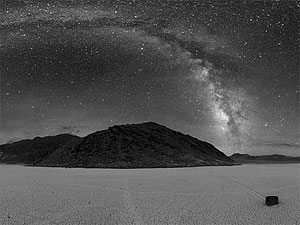There's nothing like a trip away from the city lights to remind you just how bad light pollution can be here in the Bay Area.
 The Milky Way in the skies of Death Valley's
The Milky Way in the skies of Death Valley's
Devil's Racetrack. Credit: Dan Duriscoe, U.S. National
Park ServiceI just got back from my semi-yearly pilgrimage to my favorite spot on Earth: Death Valley National Park. My main reasons for returning to this place again and again have mostly to do with hiking in the stunning natural beauty of the place, reconnecting with good times in my childhood, and reflecting spiritually on life, the Universe, and everything.
But, I can't go to a place like that and not feel more connected with outer space. Not only is the night sky a celestial spectacle--but it's darned cold there too, this time of year! Cold, like space. Each turn of the Earth through its own shadow is like a quick dip in the icy pool of space….
After twilight had faded, after the campfire had burned to embers--and as the frigid cold of the desert winter night started seeping through my layers of clothing--I lay down on the picnic bench and raised my binoculars to my eyes...
...and that's all I had to do. Arcing overhead was the section of the Milky Way around the constellations Cassiopeia, Perseus, Andromeda, Pegasus--a section of the sky rich in a variety of "deep sky" objects (objects typically only visible through binoculars or telescopes).
